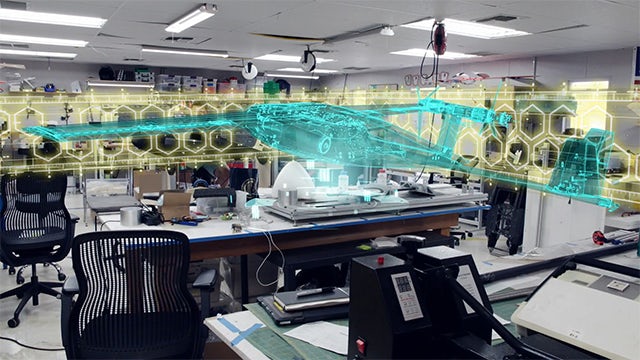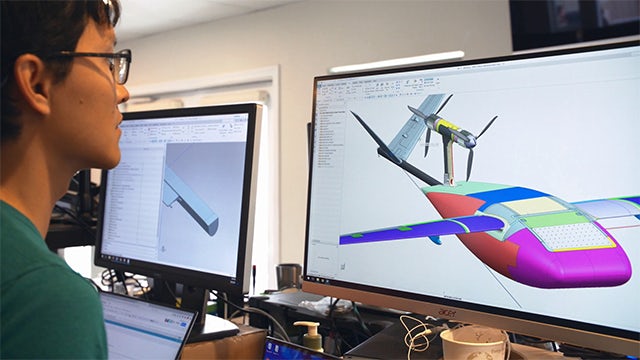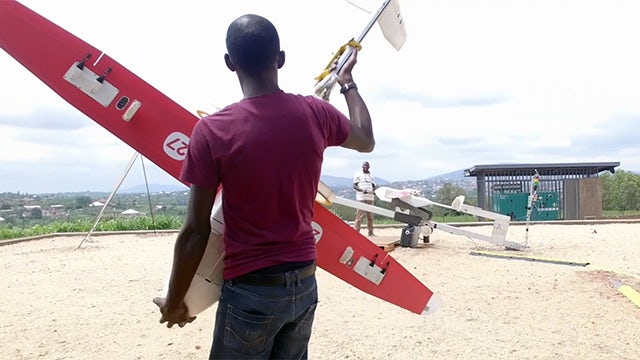NX is used to design drones that reliably deliver essential medical supplies to remote locations in Rwanda
Zipline International Inc.
Zipline International Inc., is a Silicon Valley-based logistics company that designs, manufactures and operates small robot aircraft to deliver essential medical products. With Zipline, hard-to-reach communities can have fast, reliable and affordable access to life-saving medical products regardless of terrain or road infrastructure.
http://www.flyzipline.com- Headquarters:
- Half Moon Bay, California, United States
- Products:
- NX
- Industry Sector:
- Aerospace & defense
NX has allowed us to run a very robust master scheme using wave linking in order for us to take top level masters and drive those changes through multiple subsystems.
Zipline International Inc.
Delivering medical supplies anywhere, anytime
More than two billion people lack adequate access to essential medical products, such as blood and vaccines, due to challenging terrain and gaps in infrastructure. Rwanda, a landlocked East African country with a decidedly mountainous landscape, fits the “challenging terrain” description perhaps as well as any place in the world. Recognizing this, Zipline International Inc. (Zipline) launched the world’s first drone medical supply delivery system in 2016, operating on a national scale in Rwanda to send urgent medicines to those in need seven days a week in any weather conditions.

Getting started
Zipline is a start-up based in Half Moon Bay, California, a small coastal town off the Pacific Ocean. The company has rapidly grown into a business that is disrupting the medical supplies delivery industry. Zipline has been recognized for its work serving Rwanda, but the company’s genesis comes from a visit Keenan Wyrobek, co-founder and head of product and engineering at Zipline, made to a research institute on the coast of East Africa.
While visiting the Ifakara Health Institute in Tanzania, Wyrobek learned of a local researcher who convinced doctors around the Tanzanian countryside to text him every time they didn’t have what they needed to treat a patient. The researcher kept a massive data-base featuring thousands of entries sorted by the patient’s symptoms, what he or she needed for treatment and the eventual out-come. He learned that medical supplies are nowhere near as accessible to doctors in Tanzania as they are in the U.S., and the lack of adequate blood supplies resulted in patient deaths. He found that even some-thing as seemingly simple as topical antibiotics to treat cuts were not readily available.
In fact, Wyrobek was struck by a story of a Tanzanian adolescent who had a minor cut on his arm that got infected after a few days because he could not receive the necessary antibiotic in time. Instead of being treated immediately and thinking nothing of it as the wound healed, the infection became so bad a part of the youth’s arm had to be amputated.
As a result, the concept of flying drones packed with medical supplies to previously inaccessible countries was born.
“Those are the kinds of things that really catalyzed it for us,” says Wyrobek. “We looked at the problems people were trying to solve, the problem of logistics with traveling over dirt roads and rainy seasons for decades now, and it’s just not practical to solve it that way. And it was just obvious to us. You know we could literally fly over those roads and get these products there and have a massive healthcare impact.”

A life-saving mission
Through the use of drones, Zipline improves access to critical medical supplies by flying over impassable mountains and washed-out roads, delivering directly to remote clinics. The company centralizes supply and provides on-demand deliveries, dramatically reducing waste and stockouts. Zipline is responsible for the blood supply of the western half of Rwanda, and has made over 7,000 medical supply deliveries, supplying over 13,000 units of blood to blood-deficient hospitals.
“Our operators who are running this distribution center in Rwanda can’t be thinking about drone technology or weather concerns,” says Wyrobek. “They have to be focused on who needs what medical supply, and getting it there right on time, right away. That’s all they need to be thinking about.”
“It’s really our job on the design engineering team to support those guys. We’ve got to make a plane, a zip, which can do that in all weather and have the margin to do that. So, no matter what’s going on, that plane will get through and get the delivery done.
”To receive the medical products they need, health workers at remote clinics and hospitals text their orders to Zipline. Those products are centrally stored at the Zipline Distribution Center, enabling immediate access to even the most sensitive or scarce items. These items are packaged at the distribution center and prepared for flight, maintaining the temperature-controlled supply chain and product integrity. Within minutes of sending their text mes-sage, health workers receive confirmation that their order has launched. Traveling at speeds in excess of 100 kilometers (km) per hour (over 62 miles per hour) with an 80 km service radius (approximately 50 miles), products arrive faster than through any other mode of transport, with no pilot required. In under 30 minutes, the medical products are delivered gently by parachute into a designated area the size of a few parking spaces. Hospital staff are notified of their arrival via text message.
Zipline chooses NX
During Zipline’s early years, the company used relatively inexpensive but very basic computer-aided design(CAD) package but soon realized its limitations when it came to practical applications. Engineers found it difficult to use because it could not handle a lot of memory and had to be used with higher-cost computers. Zipline required a solution with additional functionality that could automate certain tasks and allow its engineers to interact with their CAD data-base, but also featured add-on modules.
Zipline found that NX™ software from Siemens Digital Industries Software was the ideal solution for their drone designing needs. With NX, Zipline’s engineers could load the entire aircraft into the CAD model and check the fit of individual parts against the rest of the plane. For example, if one engineer is working on a wing but needs to make sure it fits properly on the body of the plane with no interference problems, he can’t be concerned about how long it will take to load the aircraft assembly. With Zipline’s previous CAD package, engineers were discouraged by the length of time required to complete the process. NX eliminated those concerns and allowed Zipline to have multiple engineers work on the same parts in real time and see how they all fit and functioned together when they were finished.
“NX allowed us to create a shell for our entire vehicle and then work from the inside out as well as the outside in order to develop it rapidly,” says Paul Perry, mechanical engineer, Zipline. We also went from a team of three engineers to a team of nine. This is important because we need to have multiple people working in the vehicle at the same time. NX has allowed us to run a very robust master scheme using wave linking in order for us to take top level masters and drive those changes through multiple subsystems.
”NX also allows Zipline to determine the location of critical areas where high-grade aerospace materials are needed versus some other areas where they can use a plastic or foam to achieve the same structural integrity and mechanical functionality at a decreased cost and lower mass.
With the amount of medical supplies Zipline’s drones have to carry, testing for weight is critical. The ability to quickly perform thickness analysis or stress analysis to cut weight allows Zipline to save on excessive iteration and testing time to hit their targets.
“The majority of the optimization we do on this plane comes around two things: structural and thermal,” says Perry. “Clearly, mass is the most important single variable we typically optimize around, so doing structural optimization allows us to reduce mass while still maintaining our stiffness and strength goals.
”Sam Chaknova, a manufacturing engineer at Zipline, builds the components that go into the drones and designs the manufacturing cells as well as some of the fixtures for easier assembly. He is responsible for building cycle testers that Zipline uses to accelerate life testing on some new vehicle components.
“I’ve used NX to take the CAD from the design engineers and then create the cycle testers and parts surrounding that to build these fixtures and also build the actual manufacturing fixtures that we use to assemble the drones,” says Chaknova. “I use NX as well to take the CAD from the design engineers to 3D print things that make the assembly much easier for the technicians.”
NX is also a valuable tool for working with the circuit boards Zipline uses for their drones. Instead of a wiring harness, small unmanned aerial vehicles (UAVs) like those Zipline uses require complex circuit boards that have to not only replace wiring harnesses, but also perform all required avionics functions.
With the confluence of electrical and mechanical engineering in the designing and building of drones, subtle nuances such as plane balance and weight distribution from front to back have to be perfect. NX brings these disciplines together to allow Zipline’s engineers to seamlessly navigate an iterative design process and know when someone makes a change to any drone part without any delays.
Digitalization is a key component to Zipline’s drone design process. Perry says that NX, with its auto-update capability that is unique to the tool, allows Zipline’s engineers to quickly iterate and automatically update any design changes and add new features in response.

A better future through medical deliveries
Wyrobek says Zipline is combining the best of the aviation industry with high reliability robotics engineering to create reliable and fault-tolerant systems. They are bringing the level of fault tolerance often seen in kit plane avionics to UAVs so they can fly 20 to 30 planes at one time with a single operator. The majority of Zipline’s testing is based on UAV safety and reliability, making sure the drone can complete its assignment whatever weather element it encounters.
Zipline’s drones are designed from the ground up for manufacturability because this is the product they use for scaling. Each drone is equipped with intelligence to sense certain types of faults. If trouble is detected, the drone will turn itself around and back to the distribution center. Zipline can then immediately send another drone to get the order through. The reliability and safety of the drones has been paramount throughout the company’s existence, and is where much of Zipline’s engineering and testing has been concentrated.
“To supply the distribution centers with the amount of vehicles we need, we have to make it easier for them to be assembled,” says Chaknova. “We also need them to be super maintainable. That’s going to allow us to maintain it in the field and keep these vehicles running and saving lives.”
Zipline engineers design and build prototypes in California. When the UAVs are deemed ready for use with 100 percent reliability, they are sent to the Zipline Distribution Center in Rwanda. From there, the drones fly to designated areas that require blood. Zipline engineers based in California who have made the trip to Rwanda and seen the operation in practice understand the impact of their work and the difference they are making.
“That’s just an incredible experience, going there and really seeing when a plane takes off,” says Jeremy Schwartz, roboticist, Zipline. “Here in California, we’re doing an experiment, a test. When a plane takes off in Rwanda, it’s delivering blood to somebody who needs blood. It’s saving somebody’s life, and just thinking about that is an incredible thing.
“Both from an efficiency standpoint – being able to close that loop so fast – and then just from a morale standpoint, it’s just an amazing thing to work on this project and be able to see the immediate results so directly."
Zipline has launched hundreds of smart, autonomous drones on a daily basis and flown thousands of missions to Rwanda since launching its drone service. As the company continues to grow and expand, they are aiming to help more people receive the medical supplies they need, no matter where in the world they may live.
“We want to be able to iterate from our own experiences and really go from where we are today, which I think is good, to where we want to be so we can really scale and make something great,” says Wyrobek.